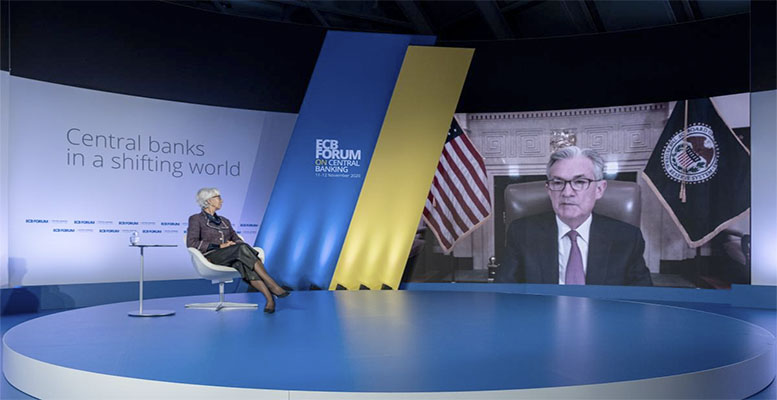Bruno Cavalier (Oddo BHF) | There are two types of central banks in the world. On the one hand, those which believe the recent rate hike is widely justified. This is the case for the Fed, at least so far. On the other hand, those who think the opposite. This is the case of the ECB, which is exasperated to see European rates rising, not as a sign of a solid recovery, but because of the contagion of the US bond correction. This shock is tightening financial conditions, but at an inopportune time as the Eurozone accumulates delays in the recovery cycle, in the vaccination campaign and in fiscal stimulus. Can the ECB control the yield curve without saying so? Former US Treasury Secretary John Connally is often quoted in regard to the dollar. Addressing European finance ministers in the early 1970s, he told them that “the dollar is our currency, but your problem.” In other words, you are on your own! Taken together, this sounds a bit like the Fed’s message on long-term interest rates. So far, the Fed is not really concerned about the correction in the bond market as it reflects improving economic fundamentals. As a result, it seems somewhat indifferent to contagion to the rest of the world, especially the Eurozone. The ECB cannot afford to adopt as relaxed an attitude to rate hikes as the Fed.
- First of all, the Eurozone is lagging the economic cycle. In fact, in addition to the strong post-lockdown rally in Q3 2020, it would be inaccurate to talk about a recovery. Activity stagnated or contracted slightly in Q4 2020 and is expected to be the same in Q1 2021. Furthermore, the eurozone is lagging far behind in the vaccination campaign, which is delaying the lifting of health restrictions. Finally, fiscal policy in the Eurozone is much less stimulative than in the US. It is reasonable to wonder about the risk of overheating in the US, but not in Europe.
- Moreover, the ECB’s communication on financial conditions is often somewhat vague, or at least fluctuating, which is never very good for its credibility. Thus, since spring 2020, we have seen that the ECB has mainly moved to reduce intra-zone spreads. Then, starting in the summer, it became concerned about the appreciation of the euro, while stressing that it had no exchange rate target. Lately, it has focused on the level of long-term interest rates. It is difficult to say what hierarchy exists between these different variables (spreads, interest rates, exchange rates), and whether there are critical values likely to provoke a central bank reaction. This situation could push the markets to test the ECB’s resolve.
- In addition, the ECB is not entirely clear on its monetary strategy. The Fed revised its strategy in 2019 to adopt a “flexible average inflation target.” The Fed assumes to tolerate, and even desire, an inflation rate above its target to compensate for past periods of excessively low inflation. We have reason to believe that the ECB is thinking along the same lines, although the debate remains open for the time being. If the inflation rate rises to close to 3% in Germany by the end of the year, and above 2% in the Eurozone, as it is likely to, will the ECB be able to keep a cool head? This is very likely, but not 100% certain.
- In any case, in the last two weeks all ECB Council members have expressed unease about the rise in long-term interest rates in Europe, seen as an external shock, unjustified by fundamentals, and therefore undesirable. Some are concerned that the recent increase in long-term interest rates is reflected more in an adjustment in real rates than in expected inflation. In general, all have expressed their resolve to combat this trend, albeit to varying degrees from one to the other.
What the ECB can and cannot do
- It is highly unlikely that the ECB will formally follow the path of yield curve control (YCC), as Japan and Australia have done by targeting 10-year and 3-year rates. The strongest stance in favor of intervention to lower long rates came from Fabio Panetta, although he was careful not to talk about such control. The only advantage we can see in his stance is to counter ECB Governing Council members who believe that the ECB is already doing too much, even too much. Probably to keep the old guard happy, Christine Lagarde pointed out not long ago that it might not be necessary to use the entire PEPP envelope (chart lhs). In our view, the ECB should rather indicate that the PEPP ceiling is adjustable according to intervention needs, and not the other way around.
- As for the use of the PEPP, since its creation in March 2020, the pace of purchases has fluctuated, downward during the vacations, and upward in period of stress. From week to week, technical factors can come into play, so caution is warranted when interpreting weekly variations in purchases. The most recent data cover the period from February 25 to March 3 (which includes the mini-dip in the US bond market). They show that net PEPP purchases have not increased, quite the contrary. They are even lower than the €15 billion/week average observed recently. It will be interesting to hear from Ms. Lagarde on Thursday on this apparent disconnect between words and action.
- It is clear that the ECB is partly at the mercy of US interest rate developments and the Fed’s reaction. It is also dependent on fiscal policy. Of course, it is not a matter of the ECB suggesting that the Fed change policy to suit, but it is well within its rights to remind member states that recovery also depends on their stimulus efforts. The stronger the fiscal policy support, the more effective monetary policy will be.





